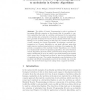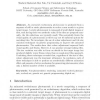75 search results - page 2 / 15 » On the Strength of Size Limits in Linear Genetic Programming |
EUROGP
2005
Springer
13 years 11 months ago
2005
Springer
We describe an approach to understanding evolved programs for a real world object detection problem, that of finding orthodontic landmarks in cranio-facial X-Rays. The approach in...
EUROGP
2007
Springer
13 years 11 months ago
2007
Springer
The ability of Genetic Programming to scale to problems of increasing difficulty operates on the premise that it is possible to capture regularities that exist in a problem environ...
ICCAD
2001
IEEE
14 years 2 months ago
2001
IEEE
This paper presents a method to automatically generate posynomial response surface models for the performance parameters of analog integrated circuits. The posynomial models enabl...
EC
2006
13 years 5 months ago
2006
Genetic programming has highlighted the problem of bloat, the uncontrolled growth of the average size of an individual in the population. The most common approach to dealing with ...
EVOW
2010
Springer
13 years 7 months ago
2010
Springer
An animated evolutionary photomosaic is produced from a sequence of still or static photomosaics to evolve a near match to a given target image. A static photomosaic is composed of...


